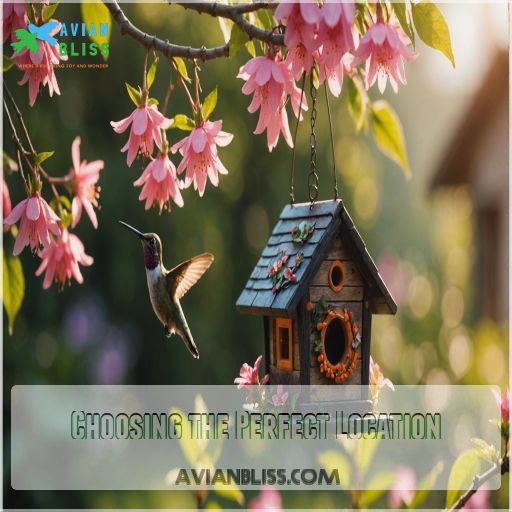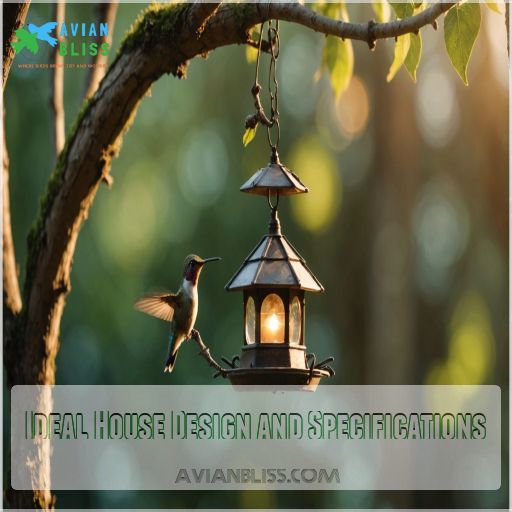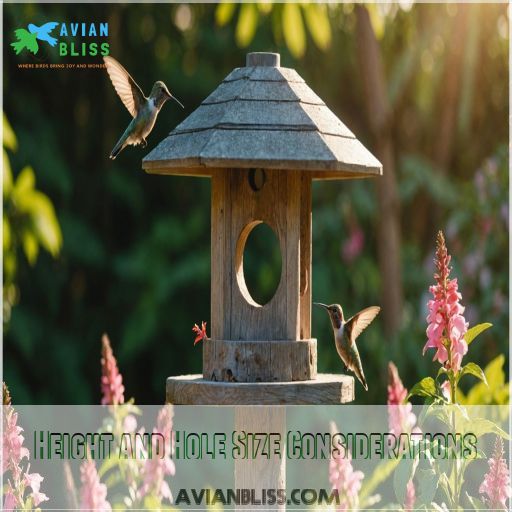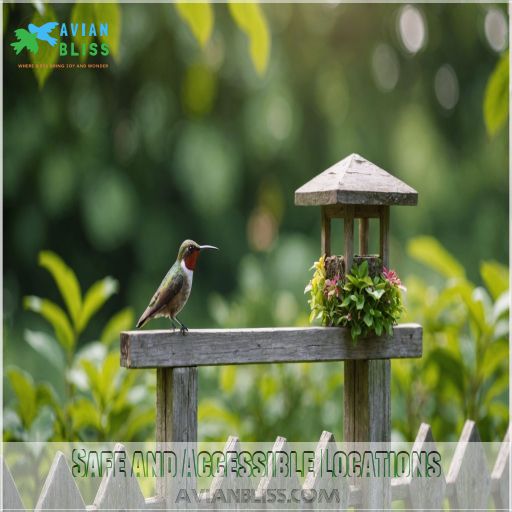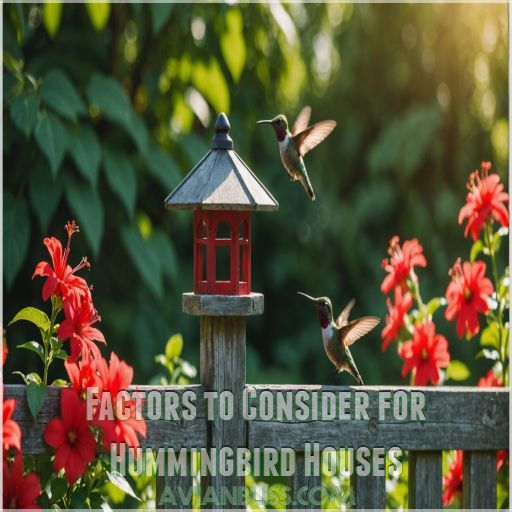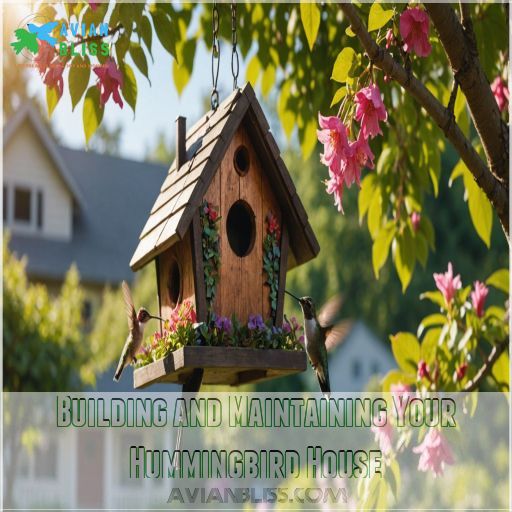This site is supported by our readers. We may earn a commission, at no cost to you, if you purchase through links.
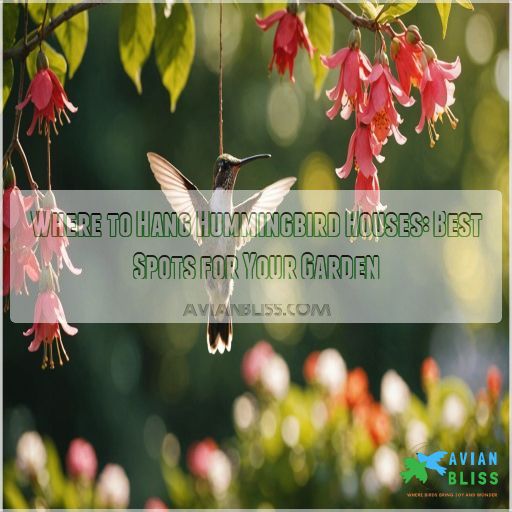 When you’re thinking about where to hang hummingbird houses, you’ll want to think like a tiny, feathered architect. Choose high, sheltered spots that’ll make your winged friends feel like they’ve scored prime real estate.
When you’re thinking about where to hang hummingbird houses, you’ll want to think like a tiny, feathered architect. Choose high, sheltered spots that’ll make your winged friends feel like they’ve scored prime real estate.
Under roof eaves or on sturdy tree branches are top choices. Avoid enclosed areas – hummingbirds aren’t looking for a man cave!
Aim for partial shade with natural windbreaks, but keep it accessible for your cleaning duties. Remember, you’re not just hanging a house; you’re creating a hummingbird haven.
Factors like nearby nectar sources, safety from predators, and accessibility for your cleaning duties are important.
With the right considerations, you’ll be the talk of the hummingbird town – and there’s plenty to think about for your miniature tenants.
Table Of Contents
- Key Takeaways
- Choosing the Perfect Location
- Hummingbird House Placement Options
- Ideal House Design and Specifications
- Height and Hole Size Considerations
- Attracting Hummingbirds to Your House
- Safe and Accessible Locations
- Factors to Consider for Hummingbird Houses
- Building and Maintaining Your Hummingbird House
- Frequently Asked Questions (FAQs)
- Where to hang a Hummingbird House?
- How to build a Hummingbird House?
- Can a hummingbird house be hung on a roof?
- Can you put a Hummingbird House under a tree?
- Where is the best place to put a hummingbird house?
- Do hummingbird houses really attract hummingbirds?
- When should you put out hummingbird houses?
- Where should you not hang a hummingbird feeder?
- How often should I clean my hummingbird house?
- Can I paint or decorate my hummingbird house?
- Do hummingbirds use houses year-round or seasonally?
- Should I provide nesting materials near the house?
- How can I protect hummingbird houses from predators?
- Conclusion
Key Takeaways
- Channel your inner tiny, feathered architect and hang houses 10 to 15 feet high in sheltered spots, such as under roof eaves or on sturdy tree branches. This gives your winged tenants prime real estate that’s safe from predators and harsh weather.
- Avoid turning your backyard into a hummingbird man cave by steering clear of enclosed areas. Instead, opt for partial shade with natural windbreaks. Your miniature visitors need room to zip around freely while still feeling protected.
- Make cleaning a breeze by placing the houses in easily accessible spots. Trust me, you don’t want to perform acrobatics worthy of a hummingbird just to maintain their cozy abode.
- Create a hummingbird fast-food chain by surrounding the houses with nectar-rich flowers, feeders, and perching spots. It’s like creating a five-star resort for these iridescent guests—they’ll be lining up to check in!
Choosing the Perfect Location
When you’re looking to hang a hummingbird house, picking the right spot makes all the difference in attracting these delightful creatures.
High and sheltered places are ideal, but be sure to steer clear of enclosed areas.
Ensure the house is both easy to clean and gently shielded from the elements.
High and Sheltered Spots
When hanging hummingbird houses, aim high and seek spots with shelter and protection. Roof overhangs or sturdy tree branches offer protection from predators and shield the birds from harsh weather.
Hummingbirds appreciate a safe and cozy haven, away from threats like crafty cats and harsh winds.
They’ll visit your hummingbird habitat when they feel secure and cared for.
Avoiding Enclosed Areas
Hummingbirds don’t thrive in enclosed areas – they need open spaces to zip around freely. Avoid hanging houses in garages, sheds, or other confined spots. These areas restrict their natural flight patterns and make them vulnerable to predators .
Instead, choose an exposed location with plenty of room for them to come and go as they please.
- Steer clear of enclosed structures
- Opt for open, unobstructed areas
- Allow for unimpeded hummingbird flight
- Minimize risks from predators
Partial Shade and Wind Protection
To find the ideal spot for hummingbird houses, think like a savvy realtor.
Seek places with partial shade and natural windbreaks like trees.
These microclimates offer perfect hummingbird safety, balancing sun exposure and wind protection. It’s like providing them a cozy, well-lit porch without the harsh gusts, ensuring your feathered guests feel both at home and secure (Source).
Accessibility for Cleaning and Maintenance
Ever struggle with cleaning regimes? Make your hummingbird house easy to maintain by placing it where you can reach it safely.
Use accessible spots for hassle-free upkeep. Consider a design that disassembles easily and opt for cleaning solutions like vinegar.
Keep your nectar fresh to attract visits, making cleaning a breeze instead of a chore, just like using the right feeder
!
Hummingbird House Placement Options
When you’re deciding where to hang hummingbird houses, think like a bird and aim high and sheltered—whether it’s under your roof’s eaves or nestled among tree branches.
Avoid turning your backyard into a nature misadventure by steering clear of enclosed spots, ensuring your tiny tenants stay safe from rain and wind while enjoying prime real estate.
Under the Roof or Eaves
Nestling hummingbird houses under roof overhangs or eaves offers birds protection from rain and wind while keeping common hummingbird predators at bay
.
- Avoid placing it too close to windows to reduce collisions.
- Use sturdy hooks for security within your bird-friendly garden.
- Enjoy the show from the comfort of your home!
Sheltered Tree Branches
Imagine your garden as a bird-friendly oasis. Hanging hummingbird houses on sheltered tree branches, you’ll win their tiny hearts! Opt for branches that are stable and thick enough to support the house.
Make sure it’s high for predator protection but stable against weather impact.
Balance shade and visibility to delight these feathered jewels.
On a Hanger Outside
You’ve found the perfect tree branch; let’s explore hanging hummingbird houses. Using hangers provides flexibility and control.
- Hanger Types: Opt for durable materials like metal or sturdy plastic for longevity.
- Visibility and Safety: Make sure the house is visible but shielded from predators.
- Wind Resistance: Choose sheltered spots to prevent houses from swaying too much.
Happy bird watching!
In Your Garden or Backyard
Your backyard is a prime spot for a hummingbird house! Tuck it into a flowering garden or hang it from a tree branch, just 10-15 feet from cover.
This gives the little birds a safe place to rest and nest, while still allowing them to easily spot your feeder.
Get creative with natural materials like cedar or gourds for an inviting hummingbird-friendly design.
| Ideal Backyard Spots | Benefits |
|---|---|
| Near Nectar-Rich Flowers | Attracts hummingbirds naturally |
| Sheltered Tree Branches | Provides cover and perches |
| Hanging from Gazebo/Eaves | Protects from weather and predators |
| Within 10-15 ft of Feeders | Allows easy access to food sources |
Ideal House Design and Specifications
When choosing a hummingbird house for your garden, go for an egg-shaped design with good ventilation; it should be easy for these tiny acrobats to flutter in through the side-entry hole.
Make sure it’s just the right size for them, made from natural materials, so they feel like they’re getting a penthouse suite with a view!
Egg-Shaped Houses With Ventilation
For a cozy nook in your bird sanctuary, consider egg-shaped houses with ventilation benefits. These designs allow airflow, ensuring hummingbirds are cool and comfortable, even on hot days.
Opt for natural materials like cedar; they’re durable and enhance your DIY construction.
Remember, climate impacts bird biology, so good ventilation is key for conservation efforts—and your garden will buzz with delighted visitors!
Side-Entry Holes for Easy Access
Imagine a tiny hummingbird zipping through your garden like a little helicopter, searching for the perfect nook to call home.
Side-entry holes in a hummingbird house cater to their preferences, offering easy access, while ensuring predator protection.
These entrances minimize disturbance and enhance occupancy, making your garden a cozy haven for these colorful visitors ,.
Size and Shape Considerations
As you consider hummingbird house dimensions, aim for simplicity and lightweight designs—an egg-shaped house with the right entry hole size makes sure those tiny tenants are comfy.
Think of it as a cozy nook, with just enough ventilation design and space for a nesting platform.
Remember, these birds value freedom and utility over opulence!
Natural Materials for Construction
Choosing eco-friendly materials for your DIY hummingbird house makes you nature’s best friend.
Use natural nest materials like twigs, leaves, and moss for sustainable construction. Incorporate spider silk, just like the birds do, for that sturdy, flexible touch.
This approach will please the hummingbirds and make your garden feel like their natural haven.
Choosing eco-friendly materials for your DIY hummingbird house makes you nature’s best friend.
Height and Hole Size Considerations
When hanging hummingbird houses, aim for a height between 10 and 40 feet to make sure your little visitors feel secure and protected from predators.
The entry hole should be just big enough, about 1.6 by 1.8 inches, so hummingbirds can zip in and out like nature’s finest acrobats.
Optimal Height for Hummingbird Houses
Hang hummingbird houses five to six feet off the ground – high enough to be predator-proof, yet low enough for the birds to easily access.
Avoid placing them too high, as hummingbirds prefer nesting spots closer to eye level.
Sheltered spots under eaves or within tree branches offer the ideal combination of visibility and protection from wind and weather.
Hole Size for Easy Entry and Exit
Now you’ve got the height sorted, let’s chat about hole size for hummingbird houses. Hummingbird preferences guide us to specific dimensions for easy entry.
Aim for hole size variations that let them zip in and out without hassle.
- Opt for a 1/4 inch or larger hole.
- Make sure the nest placement suits the house design.
- Consider predator risk.
- Relax—it’s easy!
Balancing Accessibility and Predator Protection
Balancing height and safety in your hummingbird house is like a tightrope walk. High-hanging strategies keep feeders safe from predators, especially cats.
Make sure the entrance hole suits the bird size, offering predator-proof placement without becoming a birdy barricade.
| Height | Entrance Size | Tips |
|---|---|---|
| 5-7 feet | 1 inch | Cat-safe zones |
| 8-10 feet | 1.25 inches | Secure feeders |
| 12+ feet | 1.5 inches | Safe perching spots |
Remember, don’t make it a “fortress of solitude.”
Attracting Hummingbirds to Your House
To attract hummingbirds to your yard, think bright colors and a constant food supply, like a hummingbird "fast-food chain" that keeps them coming back for more.
By providing nectar, perching spots, and vibrant flowers, you create an irresistible haven for these tiny, iridescent visitors.
Using Red or Orange Colors
Red often catches the eye of hummingbirds, acting like a flashing neon sign for their favorite dining spots.
You’ll find most feeders sporting this fiery hue, but don’t limit yourself!
Hummingbirds can see a rainbow of colors we can only dream of, including UV-tinged shades .
While red’s a classic choice, feel free to jazz up your garden with orange, pink, or even purple feeders.
These tiny acrobats appreciate a colorful buffet as much as we do!
Providing Nectar and Perching Spots
While colorful feeders catch a hummingbird’s eye, it’s the sweet nectar that will keep them coming back for more. Mix up a batch of sugar water (4 parts water to 1 part sugar) and fill your feeders (Source).
Don’t forget to provide perching spots nearby—these tiny acrobats need a place to rest their wings! Try tying red ribbons around branches or railings for extra allure (Source).
Planting Hummingbird-Friendly Flowers
If you’re thinking about attracting hummingbirds, you’re in for a treat!
Planting the right flowers can turn your garden into a hummingbird haven. These tiny acrobats love bright, tubular blooms that are easy to hover around .
Think cardinal flowers, eastern red columbine, and trumpet honeysuckle. Don’t forget to mix it up with different colors and blooming periods to keep your winged visitors coming back all season long.
Creating a Hummingbird Fast-Food Chain
To create a hummingbird fast-food chain, strategically place feeders and nectar-rich plants throughout your yard.
This approach caters to these tiny fliers’ need for frequent refueling. Mix up a batch of homemade nectar using 4 parts water to 1 part sugar.
Your hummingbird buffet should include:
- Multiple feeders in different locations
- A variety of native, tubular flowers
- Overripe fruit to attract protein-rich insects
- A water source, like a misting fountain
Safe and Accessible Locations
You’ve picked the perfect spot for your hummingbird house, but safety and accessibility are key to keeping your tiny visitors happy.
Let’s explore how to hang your feeders and houses in locations that protect hummingbirds from predators while making it easy for you to clean and maintain their cozy homes.
Hanging Feeders and Houses Safely
When hanging your hummingbird feeders, think like a tiny, feathered acrobat.
You’ll want to place them 10-15 feet from cover, giving your winged visitors a quick escape route if needed.
Aim for spots that are high enough to keep curious cats at bay but still within your reach for cleaning.
Remember, a well-placed feeder is like a VIP lounge for these aerial daredevils.
It should be positioned where you can clean it easily and the hummingbirds can visit without being harassed by other animals.
Avoiding Predator-Prone Areas
You’ve secured your feeders, but don’t let your guard down just yet! Predators are cunning creatures, always on the lookout for an easy meal.
To keep your tiny flyers safe, place their houses at least 15 feet from windows to prevent collisions . Elevate feeders and houses at least four feet off the ground, out of reach of curious cats and dogs.
Remember, a safe hummingbird is a happy hummingbird!
Easy Cleaning and Maintenance
For hummingbird houses, easy cleaning and maintenance are key.
Place your feeders where you can easily reach them for regular upkeep . Keep a cleaning schedule and stock up on supplies like brushes and vinegar solutions.
Don’t forget to disassemble and scrub all parts thoroughly .
By making cleaning a breeze, you’ll make sure your tiny visitors always have a fresh, inviting home to return to, which ensures a positive experience for these tiny visitors.
Factors to Consider for Hummingbird Houses
When selecting the perfect spot for your hummingbird house, you’ll want to think about more than just aesthetics.
Natural features, cultural elements, and neighborhood characteristics all play a role in creating an inviting environment for these tiny, feathered friends.
Natural Features and Sunlight
Now that you’ve set up a safe spot, let’s discuss nature’s influence on your hummingbird house. Sunlight takes center stage in this miniature theater. Hummingbirds relish basking in the warmth, but be mindful; excessive sun exposure can transform their haven into a sauna.
The sweet spot you’re aiming for is partial shade. Proximity to water sources enhances the appeal, creating a spa-like experience for your winged guests.
Cultural and Noise Pollution Factors
Beyond natural features, consider your neighborhood’s cultural tapestry when placing hummingbird houses. These tiny birds are sensitive to their surroundings, so you’ll want to create a calm and peaceful environment for them.
In many cultures, hummingbirds are considered spiritual messengers and symbols of love. Respect their ancestral significance by being thoughtful about the placement of their houses, much like the Caribbean spiritual connection.
Keep these three factors in mind:
- Urban or rural setting
- Local noise pollution sources
- Cultural traditions that might impact placement
Remember, hummingbirds will appreciate a quiet corner away from the hustle and bustle!
Resource Availability and Neighborhood
Resource availability and neighborhood factors play a huge role in attracting hummingbirds. Your feathered friends need more than just a cozy house – they’re looking for a full-service resort.
Let’s break down what makes a neighborhood hummingbird-friendly:
| Factor | Impact | Tips |
|---|---|---|
| Flower abundance | High | Plant native species |
| Water sources | Medium | Add small fountains or misters |
| Predator presence | High | Avoid areas with cats or hawks |
| Human activity | Low | Choose quiet spots in your yard |
Building and Maintaining Your Hummingbird House
You’ve chosen the perfect spot for your hummingbird house.
Now it’s time to roll up your sleeves and get building.
Whether you’re crafting a cozy home from cedar poles or trying your hand at a water balloon masterpiece, we’ll guide you through the process.
Creating and maintaining a hummingbird haven that’ll have these tiny visitors flocking to your garden in no time.
Using Cedar Poles or Water Balloons
For mounting your hummingbird house, cedar poles are a great choice.
They’re naturally resistant to decay and insects, making them perfect for outdoor use.
But here’s a quirky tip:
Water balloons can be a fun alternative!
Hang them near your feeder to create colorful, bobbing distractions that’ll catch a hummingbird’s eye.
Just be sure to replace them regularly as they fade.
[BOLD: Cedar poles, water balloons, replace them regularly]
Adding Nesting Materials and Accessories
Now that you’ve set up your hummingbird house, let’s jazz it up with some cozy extras. Hummingbirds are picky nesters, but you can help them feel right at home.
- Sprinkle some soft plant down or moss nearby
- Leave small twigs and leaves in a tidy pile
- Create a "spider silk buffet" by encouraging spiders in your garden
These natural fibers will give your tiny visitors the perfect building materials for their nests.
Regular Cleaning and Upkeep
Three key steps will keep your hummingbird house in tip-top shape. First, clean it thoroughly after each nesting season to prevent mold and bacteria growth. Next, inspect for any damage or wear.
As hummingbirds typically begin nesting in early spring, you need to have your house ready before they start building their nests, especially in warmer regions where nesting seasons start as early as March. Additionally, creating a suitable habitat with native flowering plants can also support hummingbirds during nesting season.
Finally, remove old nests to make room for new ones.
| Task | Frequency | |
|---|---|---|
| Spring | Deep clean | Once |
| Summer | Quick wipe | Weekly |
| Fall | Nest removal | As needed |
Frequently Asked Questions (FAQs)
Where to hang a Hummingbird House?
You’ll never guess where to hang your hummingbird house!
Place it 10-15 feet from cover, like trees or shrubs, for safety and energy conservation.
Make sure it’s visible from your favorite spot for birdwatching bliss.
How to build a Hummingbird House?
Building a hummingbird house is simpler than you’d think!
Grab a small mason jar, red plastic, and twine.
Cut holes in the plastic for a lid, assemble, and hang with twine.
Don’t forget the sugar water nectar!
Can a hummingbird house be hung on a roof?
Hummingbird houses can indeed be hung on your roof’s edge.
It’s a smart spot that offers shelter and safety.
Just make sure it’s under the eaves to protect from wind and rain.
You’ll be their favorite landlord!
Can you put a Hummingbird House under a tree?
Nature’s little dynamos prefer their cozy abodes near leafy hideaways.
You can absolutely place a hummingbird house under a tree, providing these winged wonders with shelter and easy access to their favorite nectar-rich blooms.
It’s a win-win! They get easy access to their favorite food sources.
Where is the best place to put a hummingbird house?
You’ll want to place your hummingbird house 10-15 feet from cover, like a tree or shrub.
Choose a spot that’s visible to you, shaded from the afternoon sun, and near nectar-rich flowers.
It’s like creating a cozy bird neighborhood!
Do hummingbird houses really attract hummingbirds?
Like a siren’s call to sailors, hummingbird houses can indeed entice these tiny aviators.
They’ll flock to your yard if you provide the right setup – safe perches, clean feeders, and natural food sources .
It’s nature’s own B&B!
When should you put out hummingbird houses?
Put out hummingbird houses in early spring, ideally before migration begins.
In the Southeast, hang them in February or March.
For the Midwest and Northeast, mid-to-late April is perfect. You’ll be ready for those early arrivals!
Where should you not hang a hummingbird feeder?
Don’t hang hummingbird feeders in areas with no predator cover without other cover
. These tiny dynamos need nearby shrubs or trees for safety.
Avoid spots near smoky barbecues or high-traffic areas that might spook them.
Keep it simple, keep ’em coming!
How often should I clean my hummingbird house?
Just as hummers dart in and out, you’ll want to clean your feeder regularly.
Aim to scrub it every 3-5 days in warm weather, weekly in cooler temps.
You’re keeping your tiny visitors healthy and happy!
Can I paint or decorate my hummingbird house?
You can paint hummingbird houses, but it’s best to stick with natural, earthy colors that blend with the surroundings.
Avoid bright hues that might deter birds.
Keep decorations minimal and make sure any paint used is non-toxic and safe for wildlife.
Do hummingbirds use houses year-round or seasonally?
Hummingbirds typically use houses seasonally during nesting season, which varies by species and location.
These tiny architects build their nests in spring and early summer, preparing cozy abodes for their upcoming hatchlings.
Year-round residency by hummingbirds is a rarity in most regions.
Should I provide nesting materials near the house?
While hummingbirds don’t use houses, providing nesting materials nearby can attract these tiny architects.
Offer spider silk, moss, and lichen in mesh bags or suet cages.
It’s like setting up a cozy DIY store for your feathered friends .
How can I protect hummingbird houses from predators?
To shield hummingbird houses from predators, place them 15-20 feet from windows and at least 4 feet off the ground.
This positioning can help to reduce the risk of accidents and other hazards. The location is also important for the overall safety and well-being of the hummingbirds.
Surround the area with thorny shrubs or cacti, and install motion-activated sprinklers to deter unwanted visitors.
Conclusion
You’ve now got the blueprint for creating a hummingbird paradise in your garden.
Remember, choosing where to hang hummingbird houses is like finding the perfect apartment for a tiny, feathered friend.
With the right location, design, and maintenance, you’ll be the talk of the hummingbird town.
Keep your houses high, safe, and accessible, and don’t forget to add those enticing nectar sources nearby.
Soon, you’ll be enjoying the magical sight of these winged wonders right outside your window, happy with your hummingbird hosting!

